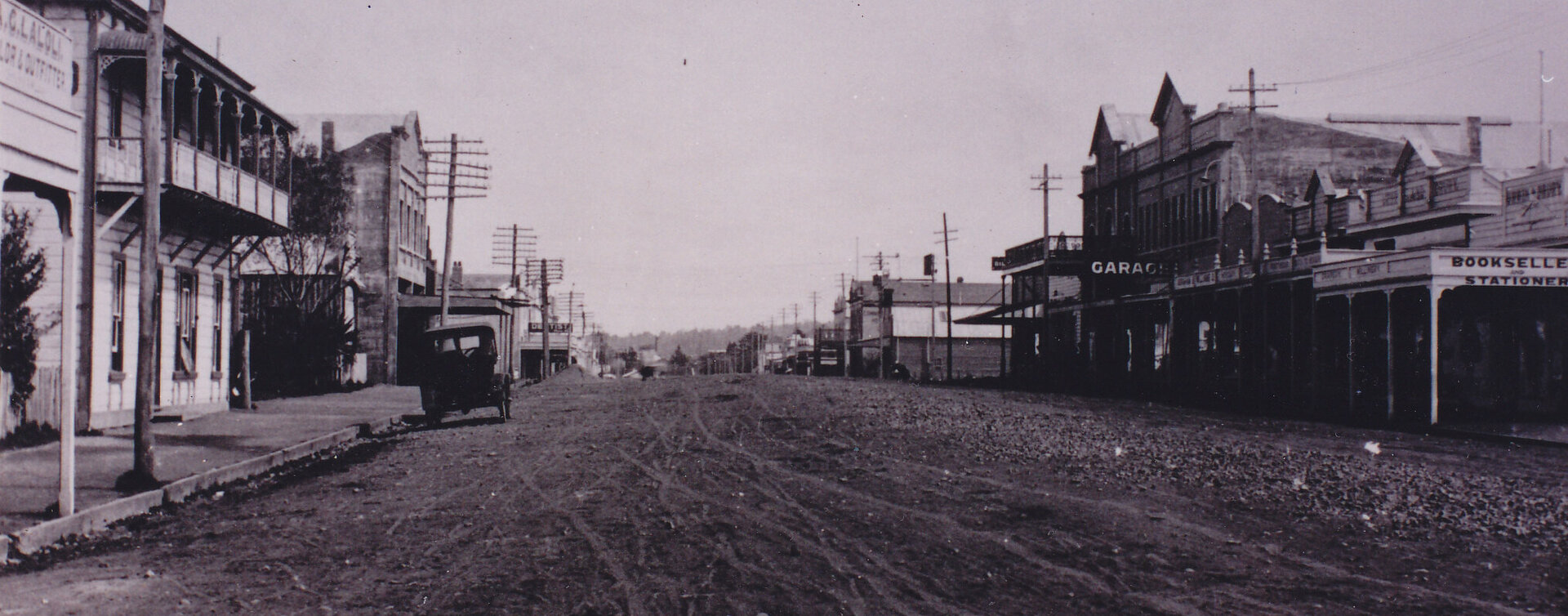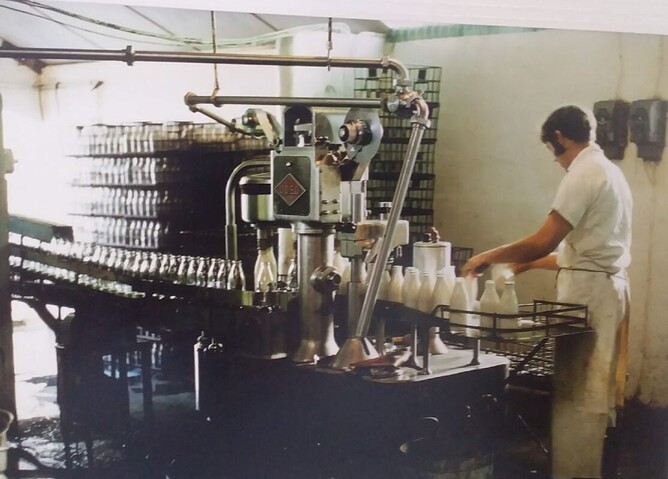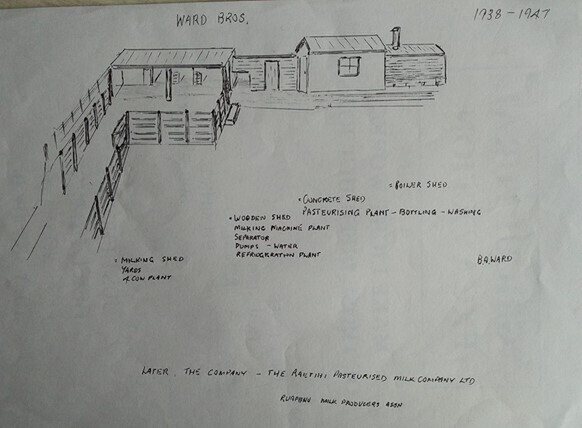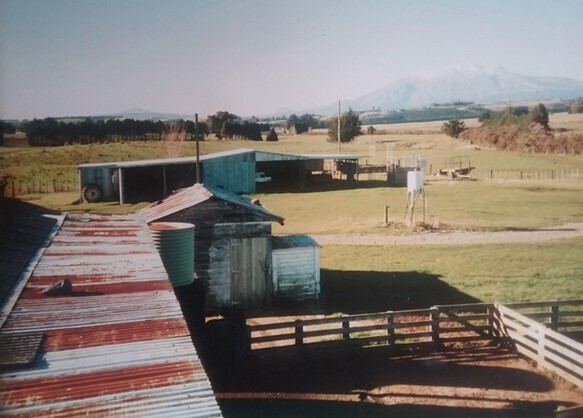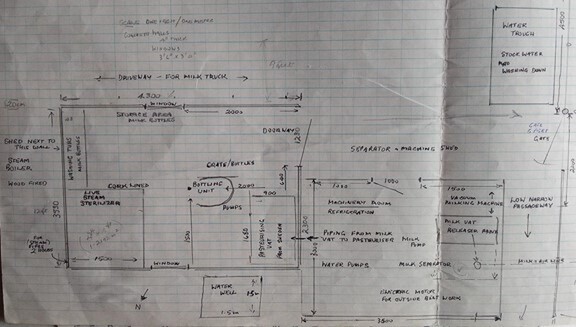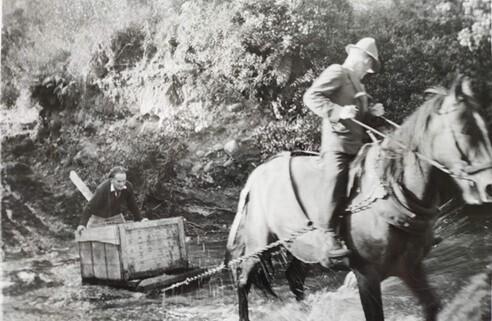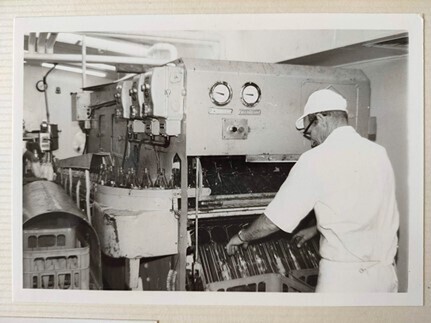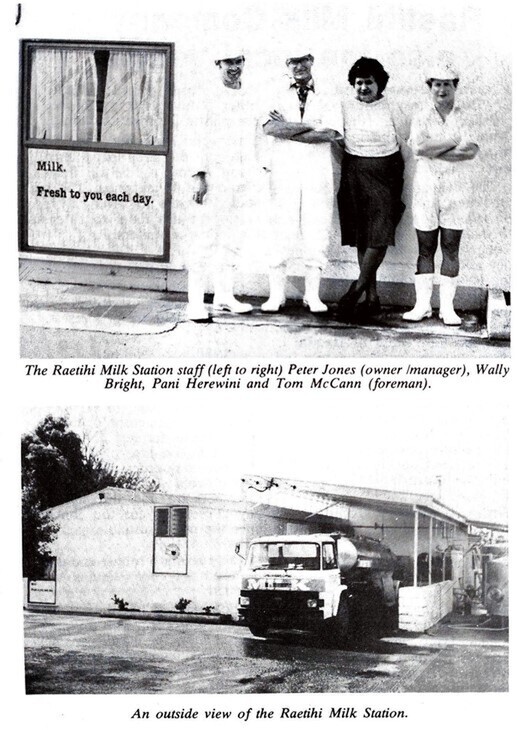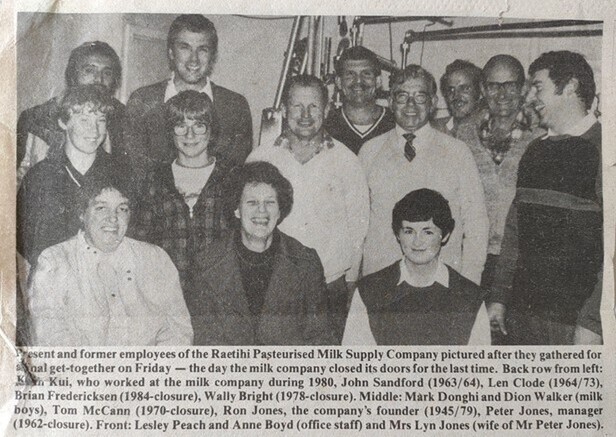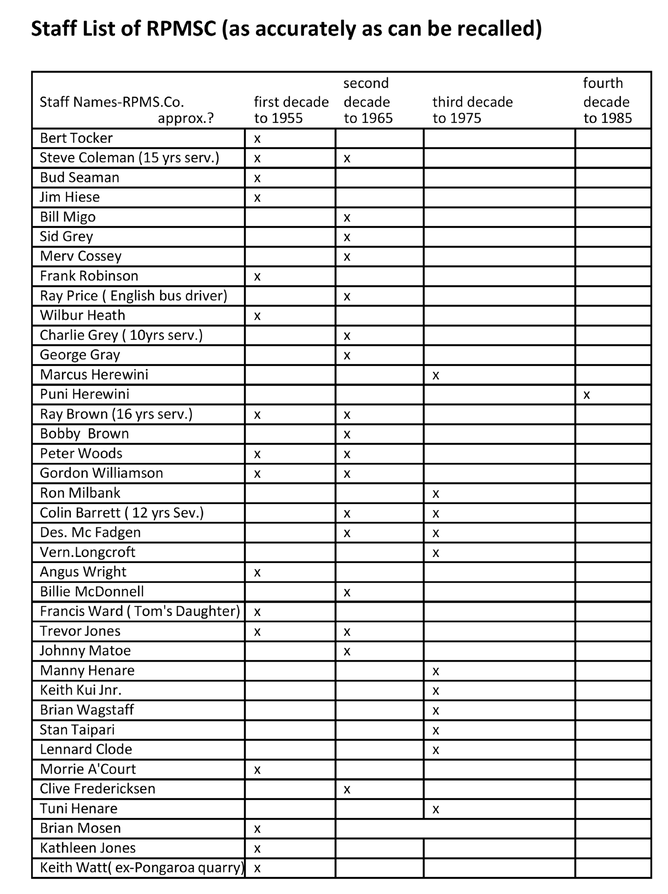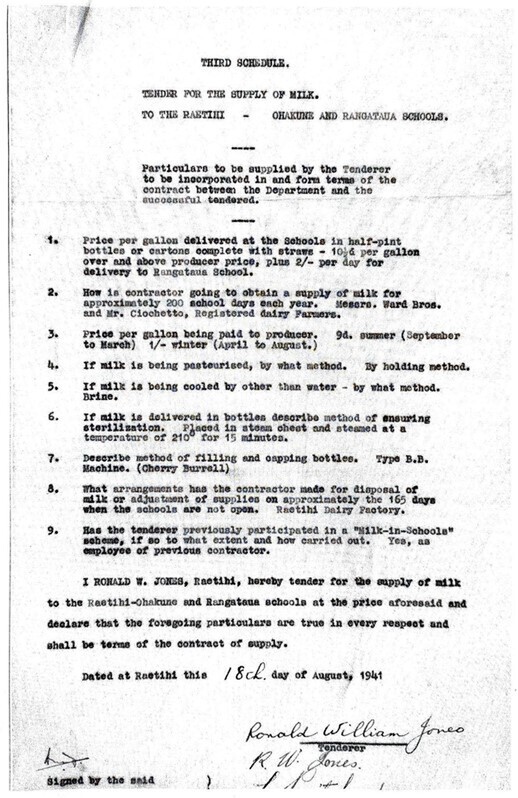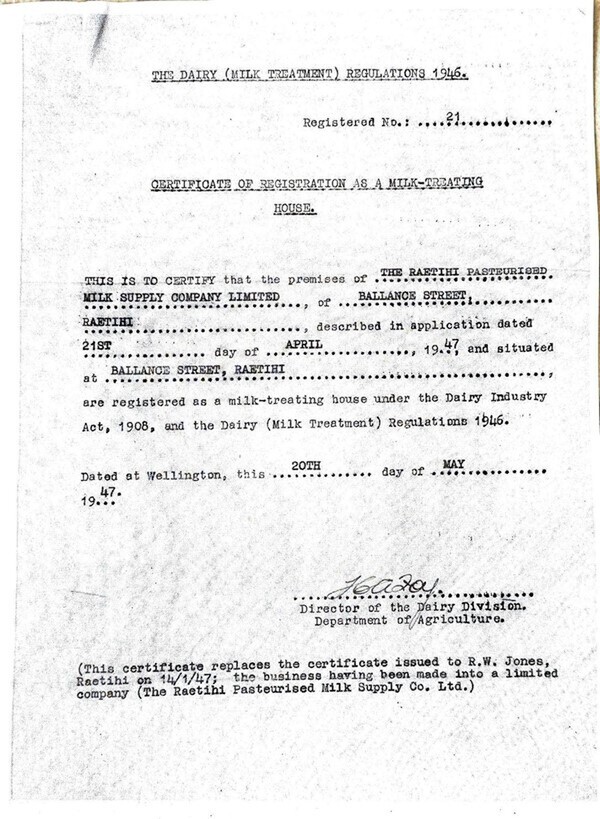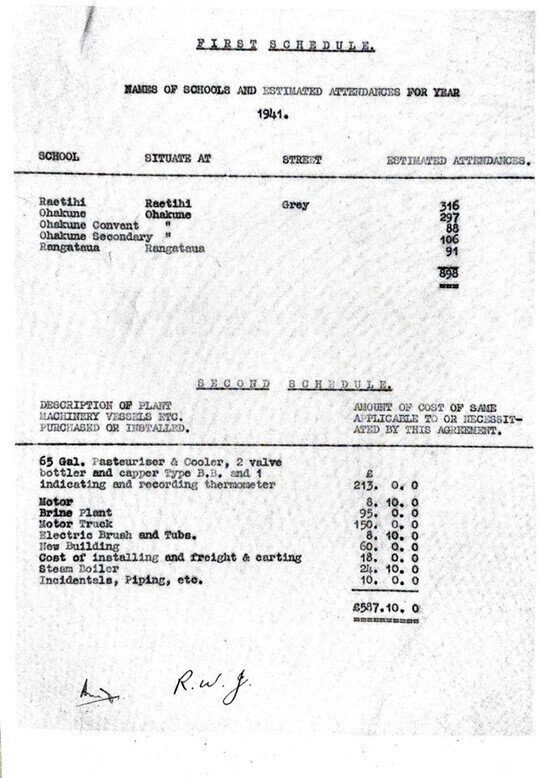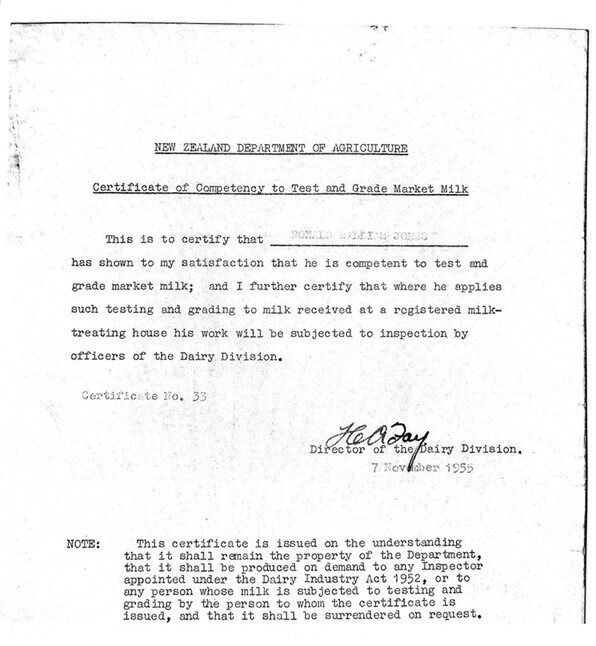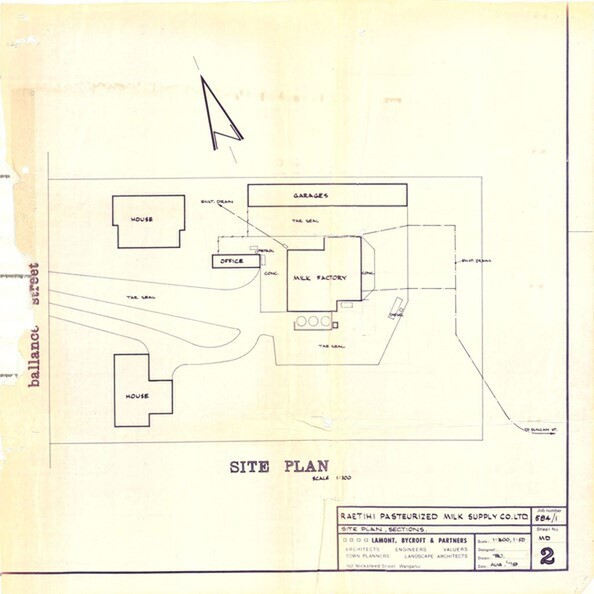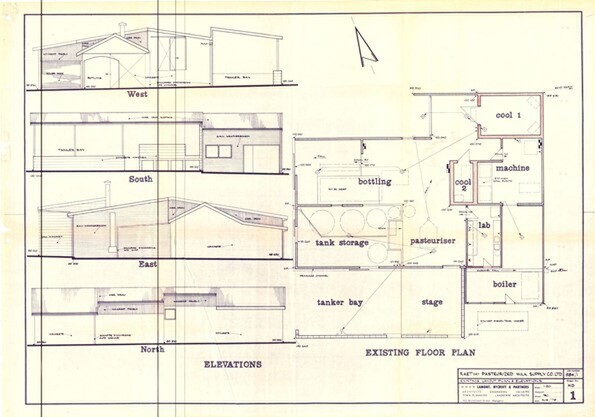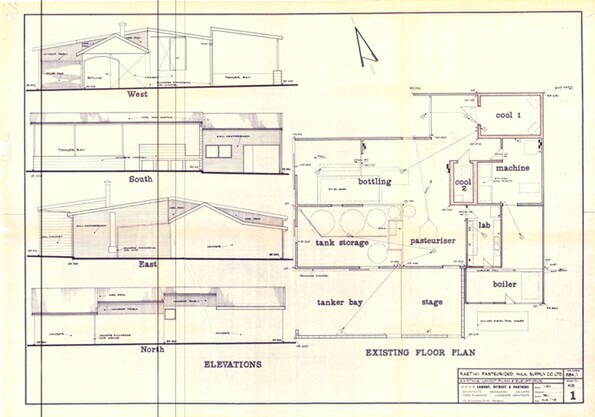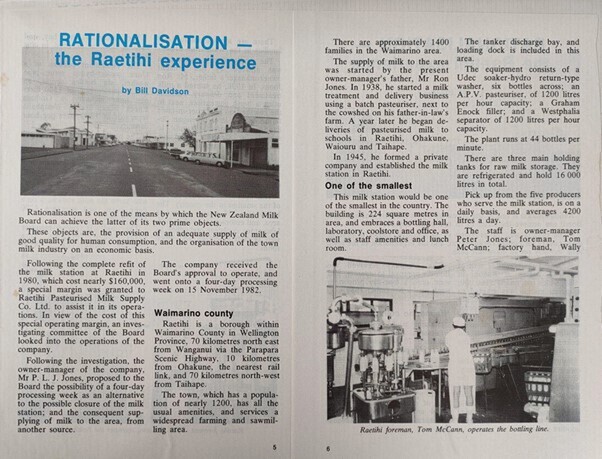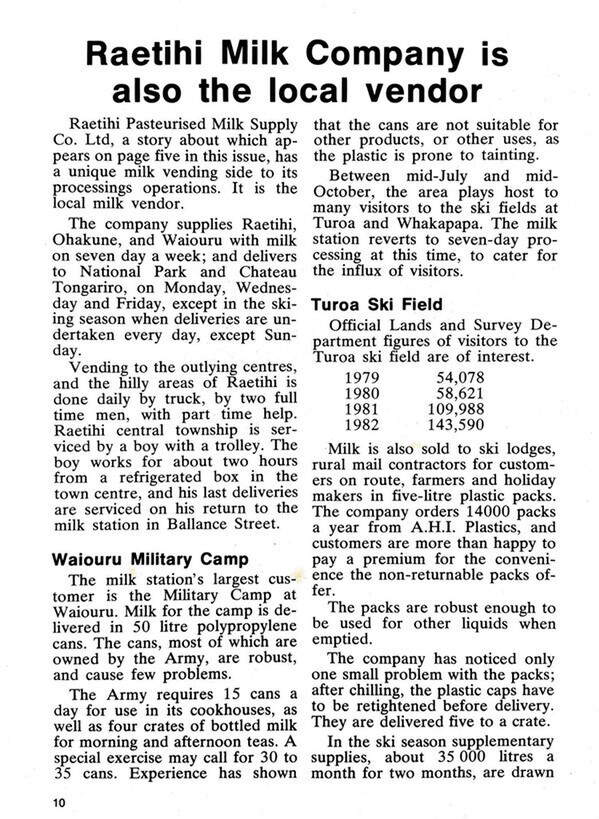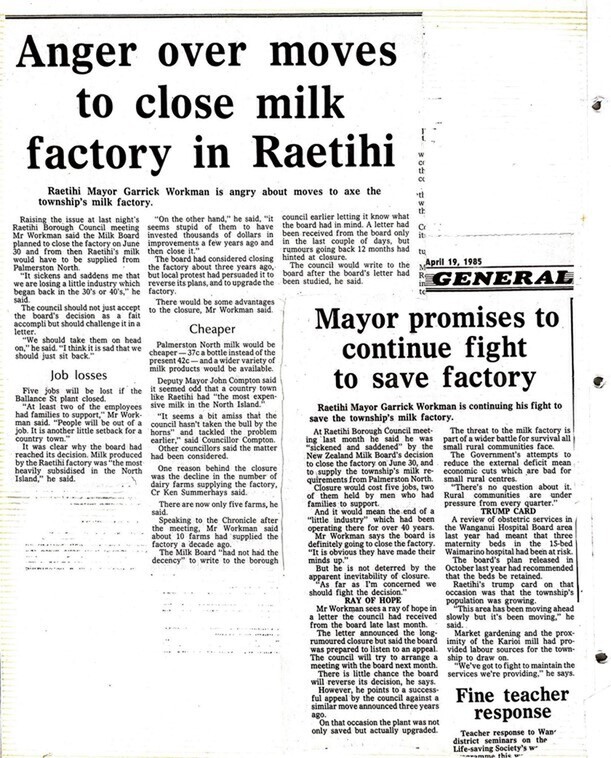This is the story of the ‘Raetihi Pasteurised Milk Supply Company Ltd’ (RPMSCo) as recounted in 1981 by Amy Lucy Jones (nee Ward) born June 1914 in Raetihi and her son Peter Jones, born Dec 1945 in Raetihi and recounted again in 1995.
Billies to Bottles & Beyond | Complied by grateful descendants | 20th Dec 2021
PART ONE: Household Billies - 1892 to 1937
In 1887 NZ Govt. purchased the Waimarino Block from Māori Iwi (Uenuku) Raetihi was already recognised by travellers as a township about 1886 and was “officially” founded in 1892. European settlers going North were arriving via the Whanganui river-Pipiriki and via Karioi. After an arduous journey by horse and dray from Wellington it became a resting point and many settled there.
During this period, (1st World War 1914 – 1918), a Mr and Mrs Joe Fletcher lived at No. 17 Ballance Street. They had no family but Mr Fletcher was kept very busy milking a few cows, separating the cream from some of the milk, and selling the raw milk and separated cream to local customers. Daily distribution was by way of a small wheeled handcart which was pushed from house to house and the milk ladled from large milk cans into smaller billies that were placed at the back doors.
Payment was manually collected every Monday and this was their sole income prior to and during the war years which also provided good sustenance to local town families. Most farmers, rural folk, had brought their own cows as milk was essential for all young families in the growing community.
The Raetihi Fire on 18th March, 1918 caused great havoc. A family of three perished and many animals, homes, businesses and sawmills were destroyed. Farms and sawmills in the more rural areas suffered greatly but people united and rallied, and with some outside help the town was gradually rebuilt over the following five years. Twenty-three sawmills were soon working again, more pioneer families were building homes on virgin bush sections. More milk was needed.
At this time most farmers, who had brought cows and milked them by hand, delivered their milk by horse and cart to the local dairy factory where it was separated and the skim milk was taken back to the farm to feed calves and pigs.
Later, with a cream separator, farmers were able to make their own butter and have the surplus cream collected by the local factory which was paid to the farmers at butterfat prices of today’s equivalent of 6 cents a pound.
As the pioneer families settled the land, the population grew, the timber from virgin bush was milled, and more farmers were arriving, also keen to augment their income by milking cows. During the 1920's, life was tough, then came the 1930 depression years that was even more so, but the tough settlers were not deterred as they built the homes and township and farmed the land.
In Raetihi, a Mr Morris and his family had also started a Billy milk round. They lived on Mr West’s farm on Hukaroa Road. Mr Morris used a handcart and his children worked from early morning, milking and delivering from Billies hanging on their bicycle handlebars. It was hard going as there were no sealed roads or footpaths in the town. The children often fell asleep during lessons at school. It is unknown what happened to Mr Morris and his family. However Mr Ciochetto (pronounced –“Shh-Cat-Ooh”) also carried cans full of milk, delivering from a horse-drawn cart
which used to know just where to stop on his rounds. Many customers remembered him dressed in cow-shed clothes and gumboots. The “tradesmen’s entrance” was always the back door where milk was measured and ladled into the Household Billy.
Following Mr Fletcher’s death, a Mr Ken Baird took over his milk round and continued until 1937 when Mr Baird himself suddenly died tragically, leaving many families without milk.
During this time, Thomas Samuel Ward owned Dorset Farms and was an early pioneer family on the Valley Road. His two sons, Albert Henry Ward and Thomas Francis Ward were milking 30 cows by hand in a small average shed on their farm and paying their father for the cows. They were getting sixpence-halfpenny a pound for butterfat which was very low income when split 3-ways.
A family friend, Mr G Clifton, suggested that the Ward brothers take over Mr Baird’s round. With the population growing and the possibility of higher income plus they were young and strong and they had a new brother-in-law, Ron Jones, to share the load, it all sounded like a good idea and so the brothers agreed to do just that. It also happened at this time that the NZ Government were concerned about the lack of adequate nutrition and the standard of children’s health was not what it should have been which eventually resulted in a ‘Milk in Schools’ programme requirement for every Primary school child to be supplied with half a pint of bottled milk every school day. This was early in 1938 and was a big step which marked the beginning of “bottled” milk in Raetihi.
PART TWO: Pasteurised Bottled Milk - 1938 to 1945
Both Albert Henry and Thomas Francis, with help from their father Thomas Samuel had the idea of establishing a Milk Pasteurisation Plant on their farm once the School programme was formalized. Albert Henry Ward had been one of the early students at the Massey Agricultural College (now Massey University Palmerston North). He was a member of the Old Students Association and was personally noted in their 1934/40 publication reading i.e.: “Mr A. H. Ward is farming in Raetihi and is supplying the district ‘Milk in Schools’ scheme”
However, there was a lot of work to do with Government planning to adopt Glass bottles, many strict Health Department and Agriculture requirements to adhere to including pasteurisation, sterilisation, bottling machinery, testing, records, process certification and new refrigeration. Glass bottles had to come by rail from Auckland in quarts, pints, ½ pints and ¼ pints for cream. All management had to be certified and operations subjected to regular inspections by the NZ Milk Board.
Undaunted, the brothers pushed ahead with even greater energy. Despite their hard farming they :
- built a small shed on the farm for the cooler house.
- set up a 2 ½ horsepower steam boiler for hot water washing of cans and bottles.
- treated raw milk, cooled and bottled in early mornings then put in the vans for delivery.
- ordered a pasteuriser from Sweden and while awaiting delivery of this
- built a solid concrete shed, designed and built to accommodate the new equipment.
- hand-dug a large well nearby Makotuku river and they were able to maintain a supply of excellent water which was essential for cleaning the many bottles by internal brushing.
- bought and installed into the separator shed with help and credit from “Farm Machinery”, a cooler from Wanganui Milk Treatment Station
- collected an old formally used butter-making kauri churn which was adapted and used to sterilise the bottles with steam.
As time passed, more customers were buying more milk which made it imperative to have a larger boiler and obviously a larger boiler house. Milk was being sold at 6d. a quart, 4d. a pint, and 1 shilling for a ½ pint of cream which resulted in more income than supplying the Dairy Butter Factory.
The system of payment from customers was in the form of perforated cardboard coupons, bought in advance, placed in each bottle which were not really satisfactory because when it rained the coupons stuck in the bottles and washing by brush insertion made them difficult to remove each wash. The rules and regulations administered by the Health Dept. were very strict. This and other problems around milk supply in the winter meant a higher demand for labour on the farm. Extra calving through winter, extra crops, extra stored hay and silage. This happened as the Second World War began in 1939, taking away most of the able-bodied men which left them with much more hard work.
The Government Health Dept. had brought in a “Milk in Schools Scheme” and the Ward Brothers obtained a contract to provide schools between Raurimu and Taihape. The smaller milk vendors could no longer compete. A new truck was purchased and Mr. Ron Jones (their brother-in-law married Amy Ward in 1935) gave up his farming contracts and moved into Raetihi township to conduct the duties around the deliveries to houses and schools, to conserve petrol and to make it easier for their children to attend school.
Note: In 1939 the National provision of milk was classified as essential health so these three men were exempted from military service.
The business grew and eventually, regardless of weather and hazards, five delivery trucks each loaded with bottled milk would set off at 4am daily to residents houses and schools in Ohakune, Waiouru township, Taihape, Raurimu, National Park, Chateau Tongariro and the Military Camp, returning to the factory about 10 or 11am with yesterday’s empty bottles for washing and re-use. Meantime a separate truck would collect the fresh raw milk from the farm suppliers between 7am and 10am, which was delivered to the factory for processing. The bottles were washed ready for filling and placed in a large refrigerated room ready for the next day’s delivery and scheduled work.
The plan was such that employment of Mr Ron Jones allowed the Ward Brothers to concentrate on their expanded farming, production and milking of their growing herd as a major milk supplier.
Opposite the Theatre Royal (Raetihi movie theatre) the Ritz Tearooms became vacant in 1940 and Mrs Thomas Samuel Ward (the brothers step-mother) bought this and it became the depot for selling milk as well as tearooms. However, many people still came directly to the new factory at 17 Ballance Street at any hour to purchase extra milk. In addition, fresh milk was being sold to the public at every annual A and P show event.
The three young men, Albert and Thomas Ward and Ron Jones, all of whom had growing families, faced many hurdles in 1938 such as bad roads, shortage of farm labour, petrol rationing, growing population and higher expectations, all pressing on their ability to continue this regional commitment for the next 7 years. Due to the high demands, they had little choice but to seriously rationalise their operations. Government’s Ministry of Agriculture restrictions were in play. Milk was becoming a serious commodity. Tenders from the Ministry and tenders were required from interested providers for school milk all around NZ. Every child at school was to be given a half pint of pasteurised milk at 10am school break. The Ward brothers’ milk delivery service had to face up to expansion. By 1941, Thomas Ward, Albert Ward, Ron Jones and Amy Jones had become partners and on 18th August 1941, Ron Jones as Manager signed a successful tender application for a contract to supply pasteurised milk to all the local schools. This resulted in increased sales demand over the whole district and required some more serious rationalisation.
See Appendix: “RATIONALISATION - The Raetihi Experience”.
The then Government introduced ‘The Milk Act of 1944’ The stage was set!
PART THREE: Government Subsidies -1943 to 1955
On 24th March 1943, a special meeting of the Raetihi Borough Council, presided over by the Mayor Doctor Feltham, was held to consider an application to erect a new Raw Milk Pasteurising Factory on the section of where Joe Fletcher had started the first milk deliveries in Raetihi. Mr Jones attended this meeting, outlined the plan and explained the need for new buildings and machinery. The Factory would be constructed on up-to-date lines, and comply with the Health Dept. in every way. The job would involve the extension of the town sewage mains by several hundred metres into 17 Ballance Street, a larger boiler, more vehicles, refrigerators and more land was required.
See Appendix: “ SITE PLAN” and “FLOOR PLAN”.
The Council unanimously concluded that district wide distribution of Milk was essential and approved the application. As expected this set the stage for farmers to provide a continuous minimum supply of raw milk every day over the next forty years. A new company called “The Ruapehu Milk Producers Association” (RMPA) was officially formed by those individual farmers who undertook a farming co-operative, to make milk available from their farms all year around, every day seven days a week regardless of weather and hazard. A tribute here must be given to this group of farmers who never failed, under many difficult seasons at times, to provide the raw milk required.
* A list of suppliers is at the end of this discourse)
Immediately after Council approval was legally confirmed another new company was formed to subdivide and own more land, to own and oversee the construction of the new factory, procurement of new machinery and vehicles, processing of the milk and district wide distribution. This company was called- “The Raetihi Pasteurised Milk Supply Co. Ltd.” (RPMSCo), Ron Jones became the Manager and even more technical facilities and buildings were required.
Mr H Sandford was appointed as the builder and the work began in June 1944
Many people (some families still in the locality) can look back at some measure of service to or from or within the RPMSCo. Also the local tradesmen and essential services both willing and loyal who supported the needs of the Milk deliveries that had developed across the region from Raetihi Northward to National Park, Raurimu and at times Taumaranui, through to Hihitahi just north of Taihape (and at times, Taihape) including the ever expanding Waiouru Military camp, and the fast growing tourist Whakapapa and Turoa Ski fields that had developed.
This service continued operating between 4am until 8pm under Ron and Amy Jones- 365 days a year, 16 hours a day for the next 40 years from 1944 until the company ceased operating on Friday 28th June 1985.
Between 1950 and 1980 there were many challenges, dealing with glass and hot water pressure and steam during washing and pasteurising. It was risky and some accidents did happen. On one occasion fingers were cut off; slipping on the wet floor was always an issue; sometimes the crates would slip off the washer exit belts. During winter, ice and frost meant the bottles had to be reversed for thawing out, the boiler had to be constantly fuelled by slabs from the mills which required hand loading truck loads of timber every few weeks. Road closures were common with ice and snow, hence innovative measures were undertaken by Steve Coleman and Bull Fowler to get the milk into Retaruke.
Of course it was not all plain sailing as many challenges arose; accidents happened; machinery had to be replaced; vehicles upgraded; family matters etc. undoubtedly, like every other person the challenges had to be overcome and together Ron and Amy met these head on. There was also the raising and education of their five children between 1936 and 1960. Four of these had grown and left Raetihi for various vocations between 1950 –1963. However the third son Peter (born 1945) was keen on the business so he stayed on from 1963 – 1985 and replaced Ron under retirement in 1975 but gradually the business reseeded due to various reasons, lack of trees meant sawmills were closing, difficult farming, modernisation and out of district attractions. Most can be described below:
PART FOUR: The Grind -1975 to 1985
The NZ Milk Board, after a great deal of Government indecision at branch level, decided that the Raetihi Milk Station could be supported. The subsidies were expected to continue.
Milk Subsidies had existed since the 1944 Milk Act legislation to re-develop so as to meet the increasingly high Treatment Standards (administered by the Ministry of Agriculture and Fisheries).
This raised a number of concerns for both the farmers and the staff presently being affected by the threat of closure because of the natural de-population of the region between National Park to the north and Waiouru to the East. Whilst both ski fields and the forestry industry were growing in activity, the overall industry changes were showing that the neighbouring milk factories would also be capable of adequately covering the supply.
In 1980, there was mostly very long-term suppliers such as The Whales, The Hammonds, The Wards (Basil and Selwyn, nephews of Amy Jones), Goldfinches, Greenwoods, Oakleys and McConachys, and some long serving staff like Tommy McCann, Wally Bright, Trevor Frederick, Andrew Condon. Other staff had not long been retired from long years of service like Ray Brown “Brownie”, Colin Barrett, Len Clode “Chicken”, Puni Herewini, Bud Seaman and others personal contributions to either factory or office work. Ms Puni, Tania Mott and Ann Boyd are of special note.
By 1982, Raetihi had a very modern factory that was the pride of Ron Jones (“Pop”' or Ron as he was known). He had seen the original Ward Brothers Farm Factory built and the concrete slab building laid by the Sandford’s in 1945. The latest milk tanker was capable of 10,000 litres so we could shift milk to and from either Wanganui or more commonly, Palmerston North. The entire factory was temperature-controlled, pressurised for air filtration. The loading facilities were all deck level and under cover. The singing during work days was common and the morning teas consisted of Girl Guide biscuits all year long with George Chan being a regular visitor to enjoy his interesting stories and activities as they related to the local Volunteer Fire Service and earlier business activities.
At this time milk had diversified into plastic 4 litre milk bottles as an option for rural delivery contractors and for use on the ski fields. This had the distinction of being the first milk station in NZ to retail milk in this way.
To keep ourselves efficient as a small operation, we had negotiated with the NZ Dairy Workers Union, the first exception to their National Roster in their history. (four days on three days off)
See Appendix: “RAETIHI MILK COMPANY IS ALSO THE LOCAL VENDOR”.Unfortunately, de-regulation of the National Milk Industry meant removal of the subsidies from all the Milk Station's and a bidding-process began to occur between other closely located factories. Raetihi was the smallest in the North Island and with the sale of the Vending Distribution side that supported the Processing side, the final bidding focused around protecting the Supplier's milking herds which had been a promise made to Suppliers Association in the 1943 meeting. However this was seriously uncompetitive. Other factories and bigger changes forced RPMSCo out.On Friday June 28th 1985:The factory machines ceased running and the premises became storage for distribution from thereon.See Appendix: “ANGER OVER MOVES TO CLOSE MILK FACTORY” and “RAETIHI MILK FACTORY TO CLOSE ON JUNE 30”.Milk of course had moved on from Billies to Bottles to Cartons to Plastics to Bags and everything in-between and beyond.
APPENDIX
An Introduction to the Ancestral Wards
Job and Rachel Maybe: English immigrants from England who arrived in Wellington in May 1841.
Elizabeth Sarah Maybe: A daughter of Job and Rachel Maybe, born in Lower Hutt, Wellington in late 1841.
Thomas Samuel Ward: An English immigrant born in Dorsetshire 1938, who arrived in Auckland aged 17 in 1855. Thomas, a father of eight, died in Marton 1915 (aged 76 years).
Elizabeth Sarah (nee Maybe): Married to John Harrison in 1861 at Marton. They had three children. John died 1865. Second marriage was to Thomas Samuel Ward in 1871. They had eight children together, continued farming in Rangitikei, Fern Flats, Crofton and Raetihi. {Elizabeth died at Marton in 1922 age 80 years}.
Thomas Samuel Ward (2) first son of Thomas Samuel and Elizabeth Sarah Harrison
{nee Maybe} He established Dorset Farms 5 km North of Raetihi. He married Lucy Ann (nee Wing) of Marton in 1906. They had three children together, Albert Henry Ward, Thomas Francis Ward and Amy Lucy Ward {1914) Lucy Ann unexpectedly died in hospital October 3rd 1916 aged 45 and laid to rest in Raetihi Cemetery.
Ronald William Jones (son of Edward) at age 13 left Portsmouth England for NZ Flock House Scheme arriving in NZ 1928. As a decorated Naval officer Edward qualified to send two sons. After six months training at Bulls Ronald was placed on Harold Manson’s farm at Raetihi next to where he soon encountered the Wards. (Ron’s brother Les died in Raetihi in 1979 age 71 also resting in Raetihi Cemetery).
After six years of local farming, milking and stumping Ronald William Jones married Amy Lucy (née Ward) the sister of brothers Albert Henry and Thomas Francis Ward, in July 1935 at Raetihi.
Essentially the Raetihi Pasteurised Milk Supply Co Ltd. (RPMSCo) was created from collated efforts of these partners plus 96/100 various local employees from 1937 until it was officially closed in June 1985.
